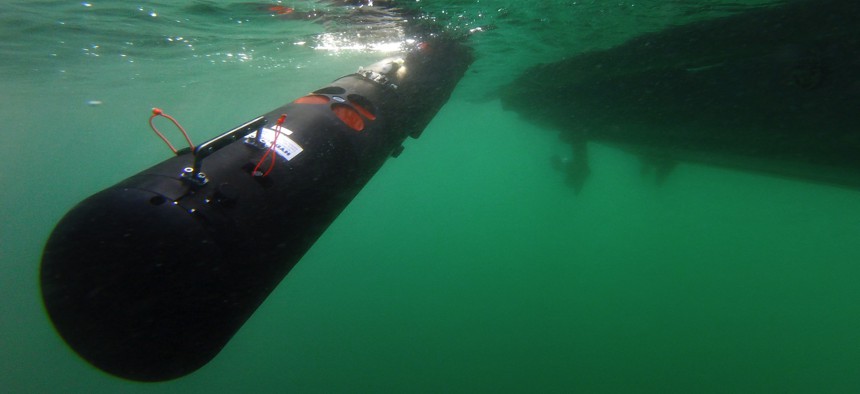
U.S. and Italian sailors deploy a Remote Environmental Measuring Units (REMUS) 100 unmanned underwater vehicle off Sesimbra, Portugal, Sept. 19, 2019. U.S. Navy / Chief Mass Communication Specialist Travis Simmons
The US Navy Needs Offensive Undersea Drones
The maritime domain has yet to see the kind of explosive innovation that UAVs have brought to land warfare.
Imagine this scenario: as tensions between Taiwan and China spike, U.S. intelligence reports that PLA Navy warships will soon sortie from various Chinese ports. In response, U.S. submarines discreetly place a set of large unmanned undersea vehicles — one per port — on the seabed floor of the Taiwan Strait. Once settled, each UUV waits for the order to release a half-dozen smaller craft, each armed with explosives and non-kinetic effectors.
The order comes and the small craft deploy, maintaining connections to a command module via acoustic and satellite links. These tactical craft loiter just outside the ports, until one by one, they detect the unique acoustic signature of their assigned Chinese warship and break off to intercept it. Once in position, three feet under a Chinese keel, each tactical UUV signals its status back to a command center and awaits the order to immobilize its target.
So far, this remains fiction. Though autonomous systems promise to bring to the undersea domain the kind of new capabilities and offensive punch that the aerial drone has brought to land warfare, the Navy has yet to fully tap their potential. Today’s UUVs are generally used for mine counter-measure operations, ISR operations, and for conducting oceanographic surveys. Naval mines, meanwhile, have progressed little since the 1970s introduced the Mk 60 encapsulated torpedo and the Mk 67 Submarine Launched Mobile Mine, although recent years have brought efforts to more accurately employ immobile mines, develop sensor packages to better discriminate targets, and even develop “smart mines” such as the Hammerhead.
The notional UUV described above would combine some of the advantages and capabilities of a fast-attack submarine (stealthy, mobile, sensor-driven pursuit of targets, ability to follow or discriminately strike at will) and those of a sea mine (even stealthier, far cheaper, present physical and psychological barriers to an adversary) — without some of the drawbacks (submarines are really expensive, and sea mines are mostly indiscriminate, counter the notion of freedom of navigation, and are really difficult to clean up once the mission has concluded).
Related: New Drones, Weapons Get Spotlight in China’s Military Parade
Related: The Five Coolest Drones from America's Biggest Naval Arms Show
Related: Toward a 21st-Century US Navy Mining Force
So, why doesn’t the Navy have them yet? There are a few potential reasons. First, much funding is and has been focused on priorities such as the USS Gerald R. Ford aircraft carrier, the F-35 fighter aircraft, and the Columbia-class ballistic missile submarine. Other funding is being directed in the wake of the National Defense Strategy, which labeled China and Russia as the United States’ great power competitors, toward the cyber and space domains, missile defense, nuclear force modernization, and homeland defense.
Second, the U.S. submarine force alone arguably gives the U.S. superiority in the undersea domain. Perhaps development efforts and resources have been directed away from areas where we are strong, to areas where we are less so.
Third, the Navy has simply not moved away from a "conventional mine warfare" mindset to embrace armed underwater drones. Perhaps the infrequent use of mines in global conflicts over the past 30 years has persuaded the Navy to allow mine warfare skills to atrophy, doctrine advancement to stall, and research and development budgets to wither.
Related podcast:
So how can we help a more effective offensive-minded UUV operational concept gain traction? First, it’s worth pointing out that the National Defense Strategy calls on our Defense Department to “increase lethality,” add “advanced autonomous systems,” and “expand our competitive space, seizing the initiative to challenge our competitors where we possess advantages and they lack strength.” In other words, while it’s important to boost capabilities in areas where we are relatively weak, it’s also important to boost U.S. superiority in areas where we already enjoy it.
Second, advanced UUVs would not need to be developed from ground zero. The Navy and private industry already operate basic models that could be developed and improved for combat use. It need not be expensive to modify existing UUV technologies to include components such as non-kinetic tools, an explosive warhead, or an acoustic guidance package and integrating them into existing command and control networks. Further, using existing “come home” technology that tells the UUV to disarm and return to a pre-determined location for recovery and/or disposal would be far preferable to cleaning up today’s mines.
Finally, the Navy must break out of its current mindset, pursue innovative UUVs and related operating concepts, then integrate them into broader undersea warfare operating concepts as a whole – just as we did with drones within the air domain.
Imagine a system of unmanned systems ready to employ kinetic or non-kinetic effects to a hostile warship or to multiple warships simultaneously. Picture an adversary held at risk and having to account for an anonymous ocean bottom-stored system of UUVs instead of simply having to account for vertical launch cells on United States’ ships or aircraft in the region. Envision the reach the U.S. Navy could have in extending sea denial and in projecting undersea power forward in support of a globally stretched submarine force. This is the future of undersea warfare.
The views expressed herein are those of the author and do not reflect the official policy or position of the U.S. Navy, U.S. Department of Defense, or the U.S. government.
NEXT STORY: How Trump Turned the Military Against Itself



